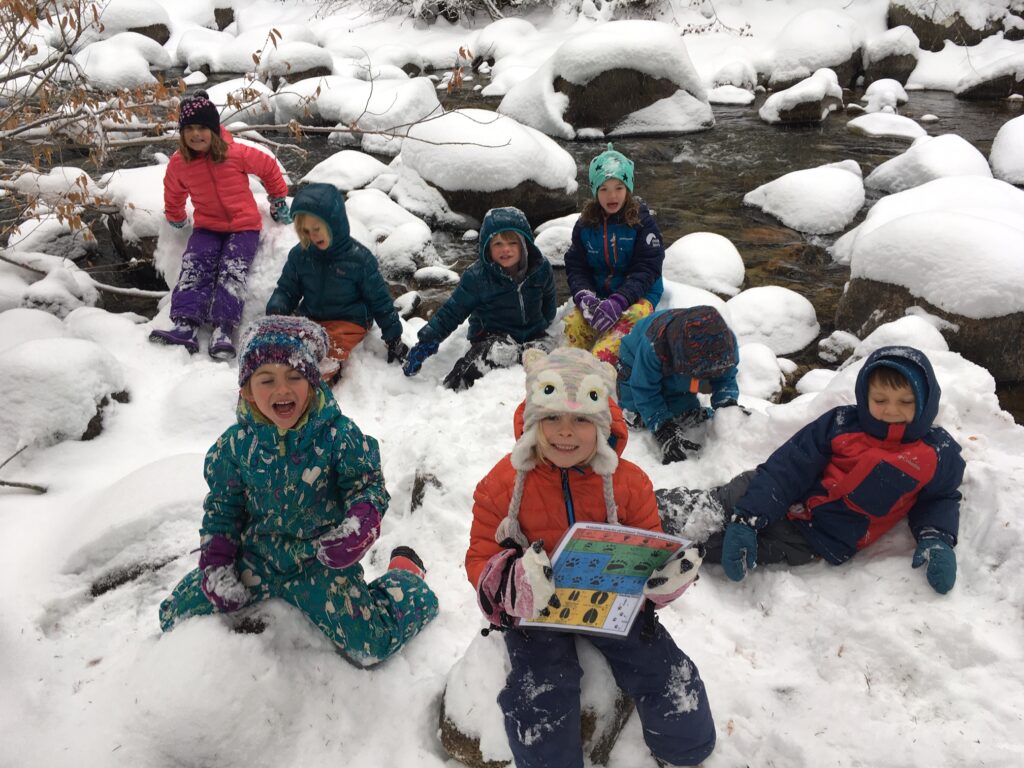“We want to help animals.”
That was what Place Network teacher, Hilary Hays, heard from her Mountain Academy kindergarten and first grade students (the Moon Stars) at the start of their year-long project. How would they do it? Hays had no idea. But, like any effective place-based education teacher, she let her students guide the way and watched as her students’ sentiments transformed into real-world, interdisciplinary learning that would impact their local community in a big, big way.
So how did their collective idea evolve?
Let’s dive in and see!
Exploring Students’ Questions

The beginning of any great inquiry project starts with questions…lots of them! And it was no different for this project. Helping animals was a broad goal and if students were going to make any kind of meaningful impact, they would need to narrow things down. Often, and especially for young learners, this process begins by encouraging students to reflect on and better understand their own place. In the case of “helping animals,” this meant exploring the wild animals that roamed students’ local ecosystems.
During the first few months, students each completed a non-fiction research mini project. This gave them exposure to a non-fiction research library that they worked together to pull from the greater school library. Scientific inquiry was a major part of this work, and students were asked to be resourceful in finding answers to their own questions. “This was difficult work for emergent readers, and lots of teacher support was necessary to make this exercise worthwhile,” shared Hays. Although challenging, it was a great opportunity for students to be exposed to the process of inquiry and research and only led to more questions that they were eager to explore!
The Driving Question
After months of inquiry, mini-research projects and visits from local experts to the classroom, students’ ideas evolved and settled into their driving question:
What adaptations do local wild animals have that help them to survive tough conditions in our environment?
With narrowed focus, the Moon Stars were now equipped to inspect the non-human components of their local community and learn more about their animal counterparts. “We loved learning about how animals deal with tough conditions associated with our local ecosystem, and related these adaptations to our own human behavior,” shared Hays. Getting first-hand experience outside in the snow allowed students to expand their personal imagination on how animals endure some of the seasonal conditions that we deal with as humans: How much energy does it take to walk through a foot of snow? Does a moose feel as cold as humans do when it’s below freezing temperatures?

Additionally, students got the chance to take a field trip to the Murie Museum where they got up-close-and-personal with specimens of local wildlife; using art to convey the intricate details they noticed in each species. Not only did these experiences touch on several aspects of their yearlong curriculum in math, literacy, writing, science and social studies, they served as a great opportunity for the Moon Stars to grow closer together, expanding their individual senses of place outwards to their local ecosystem and community.
But the question of how students could help animals was still unanswered.
A Local Issue Inspires Action

When students returned from winter break, a local newspaper headline grabbed their attention: When Wildlife Safety Turns into Fierce Political Debate. The cover story divulged a challenge local wild animals were dealing with on a daily basis, regardless of season, and one that most students had encountered before: crossing the road. The controversy, they learned, was over the proposed solutions: wildlife crossings, tunnels and bridges that funnel creatures under and over highways. Since students didn’t have direct access to view one of these wildlife crossings, they built their own prototype to see for themselves how exactly the solution worked for the animals living in their local community.
With an understanding that a local solution like a crossing, tunnel or bridge would likely take a long time and a lot of resources, students were eager to do something that would help and began a brainstorm of how they could make a difference. In the end, they came up with the idea of a sticker sale. They designed a sticker that read “Watch for Wildlife” and sold it locally, raising over $1000! But their impact didn’t end there. All of the proceeds from their sale were donated to the Teton Wildlife Rehabilitation Center — a local non-profit that works directly with local wild animals that are impacted by human life, mainly roadways that intersect their migration routes. Students invited the founders to their class for a surprise presentation of the money in front of parents and the entire school body. “The Moon Stars presented the money in the form of a big check, shared what they had learned throughout the project and threw confetti…they were thoroughly thrilled,” shared Hays. A true celebration of learning!

For most teachers approaching their teaching through the lens of place-based education, having the opportunity to connect classroom work to a local issue is incredibly impactful. “For the young learners in our class, it makes their work feel so relevant to the world they live in,” expressed Hays in her Letter to the Editor featured in February’s High Country News. As for the impact students made in their community, and how they ultimately helped animals, Hays admits, “I would have NEVER thought of this on my own…because it was student driven, the outcome was much more meaningful for my students.” That’s the beauty of place-based education!
Want to explore more student projects?


